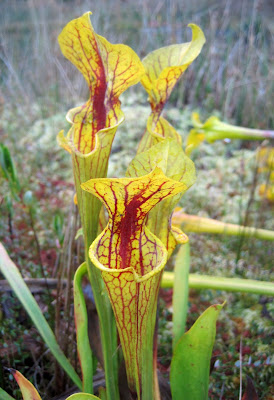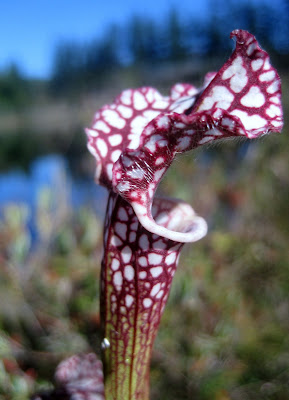
My friends Ron and Nancy Hanko ( http://www.ronaldhanko-orchidhunter.blogspot.com/ ) invited me to join them on a visit to Summer Lake; Ron's "Little Bog of Horrors". I had expressed interest and wonder over this unique place in Skagit County. Sometime in the past, no record of when, someone planted non-native insectivorous plants around this small lake. I was interested in seeing them for myself. Ron first wrote about the bog in his June 22nd entry. As usual he has spectacular photos to share. There is one photo of what appears to be a Meadowhawk Dragonfly trapped in a pitcher.
I am glad I had a personal tour. I would not have felt comfortable going into this unique environment for the first time. It was unlike anything I have ever experienced. The small lake, perhaps 1/4 mile long and perhaps 200 yards wide is located in a fairly rural area. There are no homes in the immediate area, so the who and when of the plantings takes on a bit of mystery.
I was dressing in my finest getting-wet clothes. Rain pants over jeans and my NEOS which are one piece overshoes that go on over shoes and pants legs. Ron advised my a ski / walking pole was needed so I brought that along. I didn't question it. Arriving at the lake we had to cross a small wet area to get to an island. there was an assorted collection of boards and small scraps of wood that you ventured across. They were very loosely, sorta kinda, connected to each other. I think someone used the "by guess and by gosh" method for this. I very quickly realised that this was going to be a bit more than a stroll around the edge of a lake.
I successfully crossed the planks only sinking to mid calf. The boots kept me dry. Reaching the apparent land I was in for another surprise...
It wasn't land. It was a peat island. A thick mattress of Sphagnum moss and other vegetation. The ground was spongy and in some places if you stool too long your foot would slowly sink in a bit. Most unnerving was if you walked heavy of step, the ground would quiver. It was like walking on a firm water bed. Along the way I thought I would check out the shoreline. I stuck my ski pole in, and it never reached bottom. Straight down, no bottom felt.

Immediately we found Purple Pitcher plants and Sundew. The Purples were short and wide-mouthed, growing in dense clusters.

They have tall elaborate flowers which have long since dried and gone to seed.

Most of them were filled with water and had quite a collection of bugs. This hapless moth is doomed.

Pitcher plants and other insectivorous plants produce tempting smells or sweet attractants. Bugs will enter the plant and become trapped in sticky hairs or be unable to navigate back out.
Spiders take advantage and there were many cob webs.

Sundew is a tiny native plant. The filaments hold a drop of sweet , sticky attractant. When a bug lands in the fibers, the pad curls up and traps the bug. The dead bug is broken down and the nitrogen and minerals in the body are used by the plant. Thus these plants can grow in soils that are acidic and mineral poor. These Sundews were tiny, most not bigger than the tip of my finger. Usually they were one or two pads. I did find this nice one that I can even see a remnant bug in the left-hand pad. I love how the sunlight glinted off the drops.

The Sphagnum moss is Brown Sphagnum, which turns bright red in the Fall. Wild Cranberry was everywhere but I needed a bit of a learning curve to actually see it. The berries grown right on the moss and sometimes even tucked into it. The ripe berries blended perfectly.

Ron told me to bring a container and I was prepared to pick some as we went along. I would put them in my pocket and transfer them to my backpack container periodically. They rattled nicely. They are way smaller than domestic cranberries. They also had less dense skin so I figured I could use them for baking scones. I did a little tweaking of my favorite recipe and they turned out OK!

We made our way around the south end of the lake. Ron pointed out an island at the end. He said last time it was at the opposite end of the lake. You can see another perspective of this island in the topmost photo here.

Now I know some people like to tease but I don't think that is Ron's style. Sure enough, the island is a huge raft made of very large logs/ trees. When you are up close you can see where metal spikes were used to construct it. The trees growing on the raft appear to be hemlock and Western Red Cedar and I would guess 20+ years old. I suspect that this was once someones foundation for a vacation cabin. Possibly a cabin / office for a timber pond. I got the idea to check out the lake on Google and see where the "island" was and it is clearly to the west of where it was on Saturday. Ron managed to get it embedded in his Blog Page, or you can check out "summer lake skagit county Washington"
It was here that we found an abundance of Yellow Pitcher plants.

They are taller and really stand out. From the road I could clearly see them on the other side of the lake. I now know what to look for and I suspect I might be looking for them on other pocket lakes as I drive here and there.

Some of the yellows have striking red veins.

Again many were filled with the former bugs. Many supported a resident spider that had spin some bits of web in hope to trap an arrival. Or perhaps a few well placed web strands were their own lifelines. The spiders lurked near the entry and I imagine what didn't get trapped in the web could be tackled.
I am pretty proud of this "The Time Tunnel" shot. The minute I saw it flash up on my screen after getting the shot, I remembered that old TV show. Yes it is on Hulu.

This red bug is living dangerously on the edge.

The final spot to search is for the rare and fading White Pitchers. There were only about 7-10 plants , small and straggly, clearly past their prime.
Aren't they spectacular!!!

Everyone knows this plant.

The Venus Fly Trap has a few small hairs on the inner surface of the pad. The bug needs to strike the hair once to set off a timer. If the bug strikes a hair a second time within 20 seconds of the first trip, the pad clamps shut, trapping the bug. If the bug escapes, the plant will not shut. This is an interesting energy saving adaptation. It makes sure the pads stay open to receive nutrition.. There were few Venus Fly trap plants in this small section. If there were more plants in the area they were small and hidden. Ron said there were some Cobra Lily at the opposite end of the lake but he did not find it prior to our meeting. I saw Cobra Lily at Trader Joe's this week. They are somewhat popular for having in the home.
Have your own Audrey II, just in time for Halloween.
Superb post, Marti. What fun to read about our excursion in your words and see things through your eyes. Great pictures, too. That first picture of the lake is stunning!
ReplyDeleteGreat post Smarti. "Feed Me"
ReplyDeleteYour Sister
Such an ordinary little lake from afar and so full of beauty, mystery, and scary plants up close. Loved it.--Inger
ReplyDeletethat is the fun of it. I dont think I will be able to drive past a marshy lake and not look for tell-tale yellow clusters that might mean pitcher plants.
ReplyDeleteParticularly up in this area. I wonder if the mystery gardener planted in any other lakes.